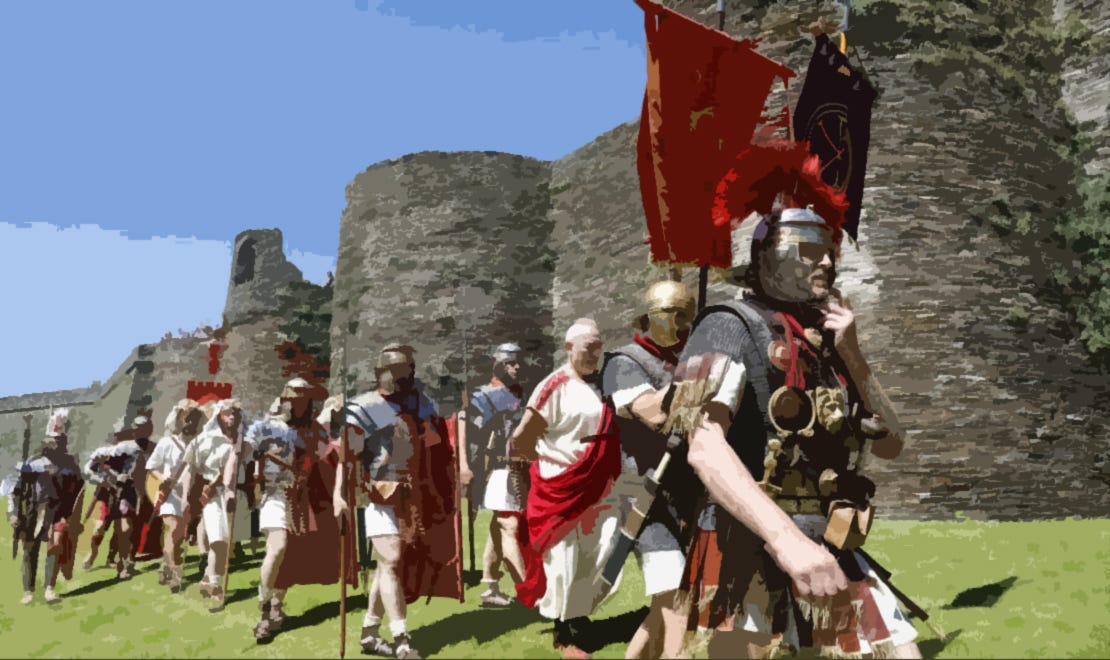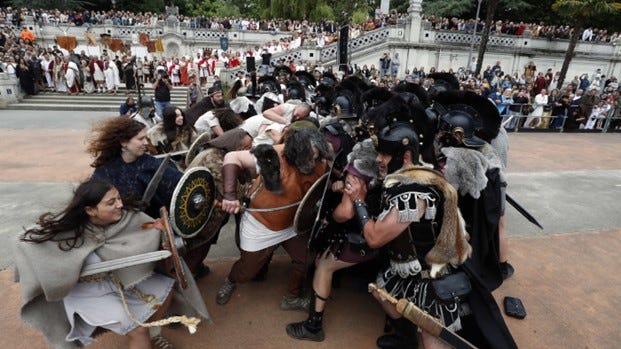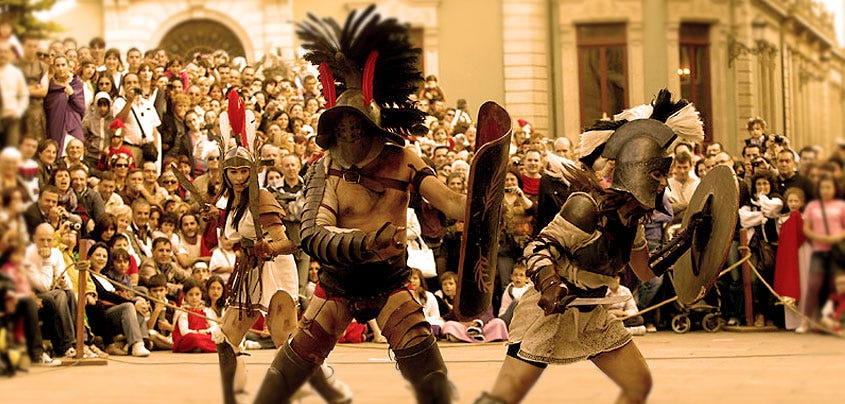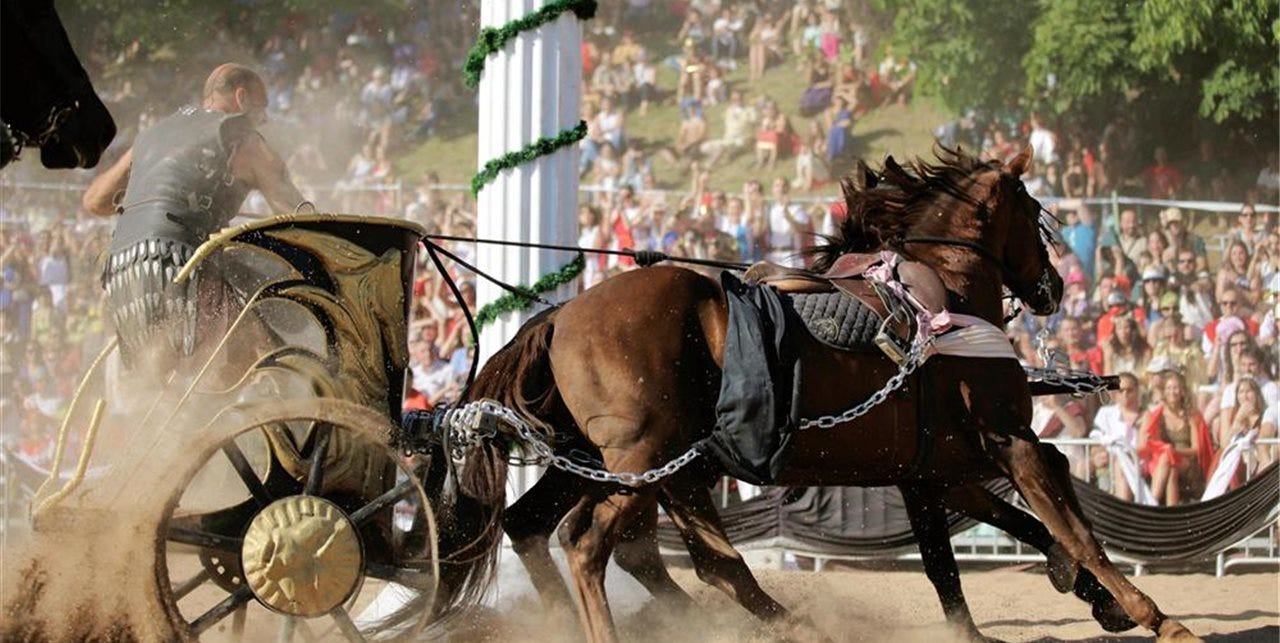🔥🛖🗡️Arde Lucus!
Galicia's most anticipated festival takes place in the ancient city of Lugo where history comes alive with a clash of cultures between local Celtic tribes and the invading legions of the Roman Empire.

Few periods in history have captured the public’s imagination as much as ancient Rome. Movies like Spartacus and Gladiator have reinforced the enduring image of a fearless and militant people intent on subjugating the known world and imposing their law and culture on the “barbarians”.
But like any great empire, the ancient Romans were a complex mob, capable of ripping slaves apart in arenas full of wild beasts and using Christians as human candles, at the same time as producing some of the most compelling and influential mythology, literature, art, and philosophy of any civilization. Not to mention engineering marvels such as aqueducts, roads and public buildings that have withstood the test of time, and a political system that has shaped and defined western governments over the millennia.
So, forget the history books, movies, and documentaries because the best place to learn about the impact of the Roman Empire on Spain is in the ancient Galician city of Lugo, the only city in the world surrounded entirely by perfectly preserved 3rd century Roman walls. Named Lucus Augusti by the conquerors, it became the most important town in Roman Gallaecia thanks in large part to the prolific gold mines that dotted the region.

Every mid-June Lugo recreates a fascinating time in Spanish history when two very different cultures collided. When the Romans made their way into the north-west of the Iberian Peninsula in 14 BCE, led by Paullus Fabius Maximus, they were met by the local Celtic tribe of Capori. These Celts were unable to put up much resistance, so quickly became part of the new Roman society, producing a blending of traditions and practices which has given Galicia its unique cultural identity.
The Arde Lucus festival was conceived to commemorate the Roman wall being declared a World Heritage Site by UNESCO in 2000. The 2,120 metres (6,960 ft) stone wall has a height of 10-15 metres (33-49 ft) and boasts 71 towers and ten gates. Its 4-metre walkway along the top of the wall makes it a great place to stroll the entire circuit for views of the historic centre and outer city. The wall, Main Square, and the 1st century CE Roman bridge play important roles in the festival activities during the four days, and with so many of the town’s inhabitants dressed in Roman or Celtic clothing combined with the accurate embellishments around the old town, it’s easy to imagine yourself transported back to Roman times.
The fact that so many local residents, schools, city associations, and sports clubs get involved in the annual festival means that a lot of thought and effort is put into its organisation to make it as historically accurate and authentic as possible. The mixture of entertainment, culture, and history has earned it the title of ‘International Tourist Interest Festival’ and every year it attracts increasingly more tourists from around the world.
Arde Lucus
Day One starts late evening and rather dramatically at the Roman bridge with the entrance of the Legions under the command of General Gaius Antistius Vitus and a re-enactment of the capture of the city. This is followed by a blessing of the troops and banners, and the lighting of the sacred fire of Vesta. No expense is spared for the costumes and weapons and the participants throw themselves body and soul into the dramatic representations.
Day Two sees a long afternoon of activities that continue well into the night. Being Spain, things don’t really kick off till midday but finish up in the early hours of the morning. Events include a parade of soldiers, Celtic tribes, senators, Vestal Virgins, and anyone else who makes up the world of 1st century Roman Empire. There is an opening of the “castra” (military base), an invocation of the Galician gods, theatre and re-enactments, tastings of local dishes, gladiatorial fights, a coin making demonstration, conferences, Roman weddings and Celtic weddings, dances, and much more.
Day Three begins with a presentation of Galician herbal medicines, war prophecies, and an assembly of Lucus Augusti. Throughout the day there are more theatrical re-enactments of historical events, a gladiator school, javelin throwing, parades, stick fighting training, a Druid Oracle, Roman Circus chariot racing, Saturnalia dances, finally finishing in the early hours with a parade of torches, the abduction of Persephone, and a fire drum parade.
Day Four is the final day which sees many of the same activities such as parades, weddings, gladiatorial fights, etc, as well as a children’s Olympic Games, a Legion attack and defence, a bestiary, a fallen legionary funeral ceremony, a basket weaving workshop and demonstrations of Celtic ceramics and Roman crafts. There are parades of Roman gods and Pan’s Labyrinth, and the festival comes to an end at 9:30 with the Vestals preserving the sacred fire of Arde Lucus.
Lugo during the Arde Lucus festival is a living museum where history comes alive - the perfect place to fully immerse yourself in the city’s Roman past. It is a unique opportunity to explore military camps and Celtic settlements, witness senate forums, religious rites, military training, and even a sale of slaves! Theatrical performances re-enact historic events and mythological stories. There are activities suitable for all ages in which participants learn about Roman and Celtic culture, visiting their settlements to gain a first-hand insight into how these people lived.
There are slaves skilled in hairdressing, aesthetics, and beauty who can style your hair in Iron Age fashion. Craft markets offer typical products, and the streets throb to the sights, sounds, and smells of magic, juggling, street musicians, and food stalls and grills. There are costume contests, horse riding, exhibitions, and bars and restaurants that serve up the best of the local gastronomy.
To really get a sense of the thrill and spectacle that is Arde Lucus, I recommend watching this video. Let me know in the comments if you’ve ever been!






I knew about the wall, but not the festival. So cool! There is very special cheesemonger in the Lugo market. He loved his cheese so much, that he almost didn't sell it to me when I told him I would put it in the car (not refrigerated) 🙂🫶 I took it back to Madrid, looking after it like a baby, on the air conditioner 🤣